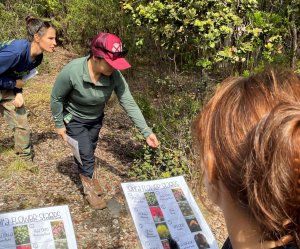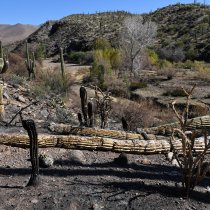Domain Digest No. 9: Mahalo to Our D20 Field Team!
April 12, 2023
D20 (Pacific Tropical) may be our smallest and most isolated Domain, but there are plenty of big things happening out there in D20! Our field staff at D20 do an amazing job engaging with the local communities, especially with STEM educators, students, and the next generation of ecologists. Here are just a few highlights from a unique Domain.
Kupa 'Āina Corps: Connecting Young Workers to Green Jobs
The Kupu 'Āina Corps (KAC) connects young adults starting their careers in Hawaiʻi with green job opportunities in conservation, agriculture, technology, clean energy, and ecology—making them a natural fit for the NEON program. In February 2022, Tristyn Wiehl joined the D20 team as a field technician and KAC participant for an 11-month term. As a result of her hard work and exemplary attitude, she was named the 2023 winner of the Kupu 'Āina Corps CHOSEN award, given to participants who exemplify the values of the program. CHOSEN stands for Character, Humility, 'Ohana (family), Service, Excellence, and Nobility.
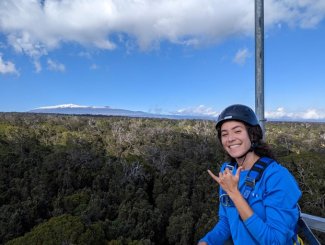
Tristyn Wiehl atop the PUUM tower with snow-capped Mauna Kea in the background
Mike Long, the D20 Manager and Wiehl's supervisor, was also awarded the Kupu 'Āina Corps Supervisor Award for outstanding mentorship. He nominated Wiehl for the CHOSEN award. "Tristyn is just an excellent person," he says. "She is very passionate about her work, very eager to learn, asks great questions, and makes great suggestions. She really wanted to understand what NEON does and why it's important. She was very much part of our team."
Wiehl connected with KAC during the waning months of the COVID-19 pandemic lockdown, when she was seeking opportunities to further her professional development in ecology and conservation. Her background in sustainable agroecology made her a great fit for the program. She says, "Kupu has been an instrumental part of creating a space for local young adults to gain experience in natural resource management. Establishing a pipeline for Hawaiʻi's youth to launch into positions within a very competitive industry is essential to encouraging a local workforce, allowing those who grew up here to remain on island."
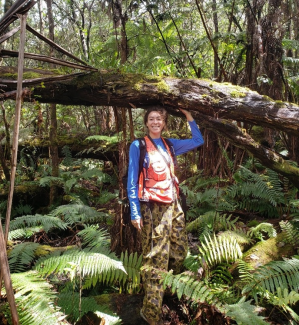
Tristyn Wiehl in the forests of PUUM
During her term, Wiehl worked with the NEON team on all D20 Terrestrial Observation System (TOS) protocols, including plant diversity, vegetation structure, mosquito and beetle collection, phenology, leaf area index, litterfall collection and sorting, and associated lab work. She also assisted with the Terrestrial Instrumentation System (TIS) maintenance. In February 2023, she returned to the D20 team as a temporary field technician (TFT). She says, "My experience with NEON exceeded my expectations and hopes. Immersing myself in an intact native, mesic ʻōhiʻa forest on the slopes of Mauna Loa has been a dream come true." She plans to continue her work in natural resource management and conservation and will begin a position with the Forestry Service later this year.
Wiehl isn't the first NEON staffer to come through the KAC program. Eissas Ouk, now the D20 TIS Senior Field Ecologist, initially joined NEON as a D20 temporary field technician following a KAC term with the United States Forest Service in Hilo, Hawaii. KAC opened the door to her career in ecology in Hawaii. "I am grateful for the experiences and opportunities provided by the Kupu ʻĀina Corps program. Being a Kupu participant really grounded my passion for ecology. It was my first real job doing fieldwork. KAC placed me in Hilo with the U.S. Forest Servicerapid 'ōhi'a death [ROD]research group led by Dr. Flint Hughes. ROD affects much of the 'ōhi'a forests on the island, and it was fulfilling to be a part of the effort that contributes to the greater scientific community." Eissas's contributions continue with her great work at NEON.
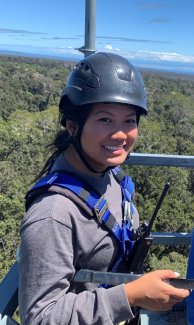
D20 TIS Senior Field Ecologist, Eissas Ouk, on top of the PUUM tower
Over the last two years, partial funding for KAC came through COVID-19 relief funds; there will be another round of funding this year to support KAC into 2024. Long hopes to see permanent funding secured to support KAC in perpetuity. "The program has been very important in getting the local community, especially young people, involved in environmental land management and stewardship. Our involvement with KAC has been great for the NEON program as a way to engage with our local communities and highlight the opportunities provided by NEON. We want people to know that NEON is a program where people can advance their careers and their passion for protecting the lands of Hawaiʻi."
Collaboration with Pilina ʻĀina Brings K12 Students and Teachers to NEON
This February and March, students and teachers from the AP Environmental Science class at Waiākea High School had the opportunity to get to know NEON and the D20 site in Pu'u Maka'ala Natural Area Reserve (PUUM). The program was a result of a collaboration between the NEON program and Pilina ʻĀina (formerly Teaching Change).
Long says, "The NAR, in addition to being beautiful, is one of the most ecologically and culturally important lands in the state. It is the last refuge for many endangered plants and animals on the islands."
Pilina ʻĀina connects K-12 students and teachers in Hawaiʻi with field experiences in Hawaiian forest ecosystems. In 'ōlelo Hawai'i (the Hawaiian language), "pilina" means "relationship" while"'āina" means land or earth which provides; the name Pilina ʻĀina represents the goal of students recognizing their connections with the lands and waters that support the life around them. The organization creates STEM-oriented field experiences in native Hawaiian ecosystems grounded in a biocultural approach. The goals are to introduce students to STEM concepts and careers while nurturing appreciation, respect, and stewardship for native ecosystems.
As part of the 2023 program, D20 staff and Pilina ʻĀina guided 22 Waiākea High School students and their teacher around the D20 field site to learn about NEON data and field data collection methods. Students explored climate and phenology data and learned about endemic, indigenous, non-native, and invasive species on the Reserve. The educational unit was led in part by Dr. Shannon Bayliss, a post-doctoral researcher from the Florida State University Department of Geography, whose work with Pilina 'Āina and research about Hawaiian forest phenology and climate change is supported by an NSF grant.
During the program, students accessed precipitation and 'Ōhi'a phenology data from the NEON portal; they calculated average precipitation and pheno-phase intensities for the three pheno-phases of 'Ōhi'a; i.e., breaking leaf buds, young leaves, and open flowers. They used the data to examine trends between precipitation and phenology. They also used phenocam imagery to generate training data for a machine learning image classification model. The image classification model could be used to identify changes in canopy structure and phenology using RGB (red, blue, green) camera data.
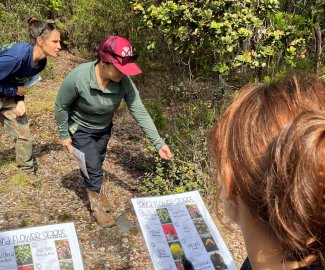
Pilina 'Āina staff, Leilā Dudley and Aleʻa Evangelista, pointing out different 'ōhi'a flower stages to Waiākea High School students in PUUM
The various methods allowed students to explore different approaches to phenological science, including the benefits and limitations of each and how they might be used to complement each other. Students also used various ways to communicate their findings, including songs, dances, children's books, and social media. Bayliss said, "It was neat to see the students lean into the fact that there isn't just one way to present and communicate scientific information. They really understood that writing lab reports or making PowerPoint presentations are not the best way to ignite interest among their community or to make people care about local ecosystems."
The NEON program initially teamed up with Pilina 'Āina in 2019 for a program with Hilo High School. While COVID-19 restrictions limited opportunities to work together for the next three years, Long is excited to be working with Pilina ʻĀina again. He says, "This program is sparking a desire for students to learn about their natural surroundings and igniting passion for protecting this important and unique ecosystem. It is also introducing them to what we do here at NEON and to STEM careers they may not have been aware of."
U.S. Forest Service Postdoc to Conduct Summary Analysis of NEON D20 Data
E komo mai (welcome) to Dr. Brandon McNellis, a post-doctoral researcher working for the U.S. Forest Service (USFS). His position is funded in part by a Cooperative Research and Development Agreement between NEON/Battelle and the USFS, which also supports NEON lab and office space at the USFS Institute of Pacific Islands Forestry in Hilo, HI.
McNellis is analyzing data sets from large-scale permanent forest plots in the Pacific, including D20, and forest dynamics plots of the Smithsonian's Forest Global Earth Observatory (ForestGeo) with an emphasis on the Hawaiʻi and Palau ForestGeo plots. His first project will be a summary site characterization and history of D20 with analyses of data collected thus far in D20. The publication will provide background and context for others wishing to use NEON data from D20.
